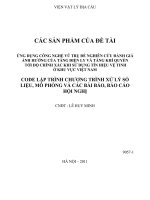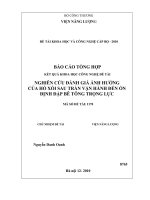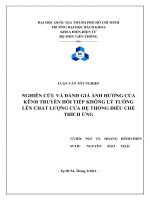Tóm tắt: Nghiên cứu, đánh giá ảnh hưởng của nguồn điện gió công suất lớn đến hệ thống điện
Bạn đang xem bản rút gọn của tài liệu. Xem và tải ngay bản đầy đủ của tài liệu tại đây (657.38 KB, 28 trang )
THE UNIVERSITY OF DANANG
UNIVERSITY OF SCIENCE AND TECHNOLOGY
⎯⎯⎯⎯⎯⎯⎯⎯⎯
VO VAN PHUONG
RESEARCH, EVALUATE THE INFLUENCE OF
LARGE-SCALE WIND POWER SOURCES
ON THE POWER SYSTEM
Major: Electrical Engineering
Code: 9 52 02 01
PHD. DISSERTATION IN BRIEF
Da Nang, 2023
This dissertation has been finished at: University of Science
and Technology, The University of Danang
Supervisor 1: Assoc. Prof. PhD. Dinh Thanh Viet
Supervisor 2: Prof. Sc.D. Tran Quoc Tuan
Examiner 1: ……………………………….
Examiner 2: ……………………………….
Examiner 3: ……………………………….
The PhD. dissertation will be defended at the Dissertation
Assessment Committee at University of Science and Technology,
The University of Danang at date
month
2023
The dissertation is available at:
-
The Information Resources Center, University of Danang
-
The National Library
INTRODUCTION
1. The reason for choosing the dissertation
One of the renewable energy sources with huge potential today is
wind energy.
However, the process of expanding and developing large-scale
wind power sources will create a great change in the power
structure of countries, causing many impacts on the power system
and electricity market. Therefore, the dissertation focuses on
researching the effects of large-scale wind power sources on the
power system and electricity market in order to solve the abovementioned problems.
2. Purpose of research
-
Research and build a forecasting model of wind power
generation capacity using artificial intelligence networks
combined with optimal algorithms. Research and build models
to serve the problem of planning and integrating wind power
sources into the power system.
3. Research methodology
-
Theoretical research combined with experiment, programming,
simulation on DIgSILENT PowerFactory, Matlab, Python
software.
-
Test the application in accordance with hypothetical power
grids.
4. Subjects and scope of research
Research subjects: This dissertation researches on wind
power sources and some related forms of renewable energy;
researches on software and programming languages Matlab, Python
for simulation and computation.
1
Scope of research: This dissertation researches on issues
related to the forecasting of wind power generation capacity,
planning issues and optimal calculation of wind power sources.
5. Scientific and practical significance of the dissertation
-
Research content published in international scientific journals
will be a reference source for authors wishing to research in a
similar topic.
-
The wind power generation capacity forecast model proposed
by the dissertation can be used for wind power plants, dispatch
centers to serve the dispatch, operation and production
planning of wind power plants.
-
The planning calculation model allows consultants and
authorities to have a calculation tool to serve the problem of
power system planning with an increasing penetration of
renewable energy sources.
-
The research results will also make a positive contribution to
the promotion of the exploitation, application and expansion of
renewable energy sources, especially wind energy.
6. New contributions of the dissertation
-
The dissertation has researched, analyzed and calculated and
evaluated the effects of large-scale wind power sources on the
power system, including the effect on power balance, short
circuit, power system stability, power quality according to the
model of wind speed changes dramatically and changes over
time in 24 hours.
-
The dissertation has researched to build a computational model
to develop and integrate renewable energy power sources into
the power system, including taking into account energy storage
2
systems. With the objective function of calculating the
optimization of investment and operating costs while ensuring
compliance with scenarios of CO2 emission reduction, the
dissertation developed a software program and applied the
calculation to the power grid. The software program proposed
by the dissertation has calculated the power structure suitable
for CO2 emission reductions in different scenarios.
-
In this dissertation, it has also researched and analyzed the
impact of large-scale wind power sources on the electricity
market, and calculated the impact of the forecast error of wind
power generation capacity on the revenue of wind power
plants participating in the competitive power generation
market.
-
The dissertation has researched, proposed, modeled and
successfully built wind power generation capacity forecasting
software with relatively good accuracy. On the basis of the
open-source programming language Python, the dissertation
combined the application of artificial intelligence networks
with swarm algorithms and genetic algorithms to build wind
power generation capacity forecasting programs according to
two models PSO-PSO-ANN and GA-PSO-ANN. The above
models have been applied to forecast the generation capacity
for Tuy Phong wind power plant in Binh Thuan province,
Vietnam. The results show that the above forecasting models
can be used for wind power plants, dispatch centers to serve
the dispatch, operation and production planning of wind power
plants.
3
-
In addition, the dissertation also researched and built a shortterm
wind
power
forecasting
model
using
Python
programming language, incorporating the TensorFlow library
to train artificial neural networks.
7. Layout of the dissertation
The dissertation layout includes introduction, 4 content
chapters, conclusion, list of published works, list of references and
appendices.
Chapter 1. Overview of wind power sources and studies on
the impact of large-scale wind power on the power system and
electricity market.
Chapter 2. Study the impact of large-scale wind power
sources on the power system and electricity market.
Chapter 3.
Study on optimizing the integration of
renewable energy sources into the power system considering
scenarios for reducing CO2 emissions.
Chapter 4. Research and build a forecasting model of wind
power generation capacity using artificial intelligence networks
combined with optimal algorithms.
4
CHƯƠNG 1
CHAPTER 1
OVERVIEW OF WIND POWER SOURCES AND
STUDIES ON THE IMPACT OF LARGE-SCALE
WIND POWER ON THE POWER SYSTEM AND
ELECTRICITY MARKET
1.1. Overview of wind power sources
Wind power is a clean energy source and has huge potential.
1.2. Research situation on the impact of large-scale wind power
sources on the power system and electricity market
1.2.1. Studies on the effects of wind power on power systems and
electricity markets
In this dissertation, PhD students will carry out research on
calculating, simulating and analyzing the effects of large-scale wind
power sources on the power system, the impact of wind power
sources on the electricity market.
1.2.2. Studies on wind power development planning
In this dissertation, PhD students will develop an optimization
computational model for integrating renewable energy sources into
the power system taking into account scenarios for reducing CO2
emissions, and integrate the energy storage system in the power
system.
1.2.3. Studies on forecasting wind power generation capacity
1.2.3.1. Classification and purpose of types of wind power
forecasting
1.2.3.2. Studies on forecasting wind power generation capacity
In general, there have been many research authors on the
problem of forecasting wind power generation capacity, each study
5
has its own advantages and strengths of each method as mentioned
above. However, errors in wind power generation capacity forecasts
can be further minimized. In this dissertation, PhD students will
propose a wind power generation capacity forecasting model using
a combination of optimal algorithms and artificial intelligence. This
proposed model can improve forecast error compared to some other
models.
1.3. Conclusion of chapter 1
Based on the above-mentioned contents on the overview of
wind power sources and studies on the impact of large-scale wind
power sources on the power system and electricity market, it can be
seen that wind energy sources have been strongly exploited.
In this dissertation, PhD students carry out research on the
effects of large-scale wind power sources on power systems and
electricity markets, and perform calculations, simulations and
analyses of the effects of wind power sources on IEEE power
systems. In addition, in order to serve the problem of planning for
the development of renewable energy sources, including wind
energy sources, the dissertation builds an optimization calculation
model for integrating renewable energy sources into the power
system taking into account scenarios to reduce CO2 emissions. In
addition, the PhD student proposed a wind power generation
capacity forecasting model using a combination of optimal
algorithms and artificial intelligence.
6
CHƯƠNG 2
CHAPTER 2
STUDY THE IMPACT OF LARGE-SCALE WIND
POWER SOURCES ON THE POWER SYSTEM AND
ELECTRICITY MARKET
2.1. Introduction
The sudden change in generation capacity of wind power plants
increases uncertain factors in the operation of the power system, so
the operating costs of the whole system increase.
2.2. Turbine, wind generator models
2.2.1. Classification of wind turbines
According to the structure, there are 02 types of wind turbines:
Vertical axis and horizontal axis.
2.2.2. Wind turbine structure
2.2.3. Wind turbines use grid-connected permanent magnet
synchronous generators
2.2.4. Wind energy and wind power
Wind turbines convert the kinetic energy of the wind into
mechanical energy to rotate the wind turbine.
(2.1)
2.2.5. Generator-side and grid-side converters
2.2.6. Wind turbine pitch controller
2.3. Impact of large-scale wind power on the power system
2.3.1. Power balancing and stabilizing the power system
Unpredictable variation in generation capacity of wind
power plants may lead to a power imbalance in the system and may
affect the stability of the power system. Any power imbalance
7
affects the system frequency and can cause unsynchronization and
instability in some cases.
2.3.2. Power quality
Wind power plants can assist in regulating and maintaining
voltage in the system in faulty situations.
2.3.3. Effects on power transmission lines
In case the power system does not have a good link between
regions or countries, there may be situations of system congestion
and the power generation of wind power plants must be limited.
2.3.4. Influence on optimal operation of power plants
Depending on the level of penetration and characteristics of
the system, wind power plants also affect the efficiency of other
power plants in the power system (and vice versa).
2.3.5. Security of power supply and environment
Wind power plants play a role in maintaining the stability
of the system and contribute to meeting the demand for power
supply to the load. At the same time, the development of wind
power sources plays an active role in contributing to reducing
greenhouse gas emissions, protecting the environment and ensuring
the security of electricity supply.
2.4. Research, calculate and analyze the impact of wind power
sources on the power system
2.4.1. Research grid
The IEEE grid diagram is built on DIgSILENT software,
including 03 power plants, 03 stepup transformers, 09 busbars, 06
transmission lines and 03 loads. From this IEEE diagram, in the
dissertation add 02 wind power plants. The Wind1 wind power
plant connects to the Wind1 busbar, through 01 T_Wind1 stepup
8
transformer with voltage level 13.8/230kV to connect to node 5 of
the original grid. Similarly, the Wind2 wind power plant connects
to the Wind2 busbar, through 01 T_Wind2 transformer with voltage
level 13.8/230kV to connect to node 8 of the grid.
2.4.2. Simulation results
The dissertation conducts simulation of grid calculation in
03 scenarios:
•
Scenario 1: There are no wind power plants involved in the
power system.
•
Scenario 2: There is a Wind1 wind power plant participating in
the power system.
•
Scenario 3: There are wind power plants Wind1 and Wind2
participating in the power system.
In scenarios, Wind1 wind power plant operates in 30MW
fixed capacity generation mode, Wind2 wind power plant operates
in 30MW fixed power generation mode.
2.4.2.1. Power flow calculation
The calculation results show that depending on the structure of
the power system and the structure of the generation source, wind
power plants can have different effects on capacity losses in the
power system.
With the participation of the wind power plant in the system,
the voltage at node 5 has been improved, increasing from 0.996 p.u
(in scenario 1) to 1.015 p.u (in scenarios 2 and 3). Similarly, the
voltage at node 8 has also improved, increasing from 1.016 p.u (in
scenario 1) to 1.019 p.u (in scenario 2) and to 1.023 p.u in scenario
3. The voltage at other nodes is also relatively well improved
according to the higher the penetration of wind power sources.
9
2.4.2.2. Calculation of short circuit
The dissertation conducted a simulation of the calculation
of 03 phases to ground short-circuit for all nodes. The calculation
results showed that in the study scenarios, wind power plants had a
negligible effect on the short-circuit current value at the nodes.
However, depending on the installation location, capacity of wind
power plants as well as other parameters of the power system, wind
power plants will have different effects on the short-circuit current
at the nodes.
2.4.2.3. Contigency Analysis
The dissertation performs a simulation of electrical system
contigency analysis when n-1 and n-2 incidents occur on
transmission lines.
2.4.2.4. Calculation of the transition process
The dissertation conducted simulation and analysis of the
transition process when a direct short-circuit of 03 phases to ground
occurs at the busbar at node 8.
Comparing 03 cases, it can be seen that the greater the
penetration of wind power sources participating in the power
system, the stronger the voltage at the nodes and the more
waveform distortion. In this case, voltage sinusoidal waveform
distortion lasts longer and turns off more slowly than in the absence
of a wind power plant involved in the power system.
It can be seen that in all 03 cases there is not much difference in
fluctuations in the speed of the transmitter and the system
frequency. Particularly, the rotor deviation angle of the generators
in the case of a wind power source participating in the system has a
greater value than in the case of no wind power plant.
10
2.4.2.5. Effects on the electrical system when the wind speed
changes suddenly
The dissertation conducted simulation and analysis of the
effects of sudden changes in wind speed in case all 02 wind power
plants participate in the power system.
Figure 2.34. Oscillating power of plants, voltage when wind speed
changes suddenly from 14 m/s to 2m/s
If the wind speed changes suddenly from 14m/s to 2m/s, it
causes fluctuations in the generating capacity of plants in the power
system stronger than if the wind speed only decreases to 9m/s.
2.4.2.6. Impact on power system operation over time
The simulation results show that when the capacity of wind
power plants and loads changes over time, the voltage at the busbars
with power plants is kept stable, while the voltage at other busbars
fluctuates but remains within the specified limits.
2.5. The impact of large-scale wind power sources on the electricity
market
2.5.1. Influence on market prices
Wind power affects prices in the electricity market in a number
of ways:
11
•
In general, electricity prices are expected to be lower during
periods of high winds compared to periods of low winds.
•
If the existing capacity to release capacity cannot meet the
demand for electricity transmission (from one region to
another), then the power supply area will be separated from the
rest of the electricity market and form its own pricing area.
2.5.2. Increased costs for ancillary services
When the penetration of wind power plants into the power
system increases, ensuring system security requires increasing the
level of capacity redundancy due to the instability of the generation
capacity of wind power plants, leading to an increase in operating
costs of the whole system as well as an increase in costs for
ancillary services on the system.
2.5.3. Impact on the financing of wind power plant participation
in the electricity market
The accuracy of wind power capacity forecasts affects the
selling and purchasing prices of power plants:
•
If the amount of power produced is more than the forecasted
capacity, then the excess capacity will be resold at a lower
price.
•
If the amount of power generated is less than the forecasted
capacity, then the amount of missing capacity will have to be
purchased at a higher cost.
2.6. Study on the impact of wind power generation capacity
forecast errors on the revenue of wind power plants
participating in the competitive power generation market
The results show that in case the wind power plant offers the
market price according to the forecast results according to the GA12
PSO-ANN model (with a MAPE error of 4.52%), the loss of
revenue in 24 hours (calculated on 01 turbine) is 60,636 VND/kWh.
Meanwhile, if the bid is based on the forecast results from the
Adam-ANN model (with a MAPE error of 7.79% - higher than the
GA-PSO-ANN model), the corresponding loss is 113,312
VND/kWh, 1.87 times greater than the GA-PSO-ANN option.
2.7. Conclusion of chapter 2
In this chapter, the dissertation presented an overview of the
effects of large-scale wind power on the power system.
The
dissertation has calculated, analyzed and simulated the effects of
large-scale wind power sources on the IEEE grid model. The results
of calculations and simulations are shown in detail through specific
tables, charts and analysis.
In this chapter, the dissertation also presented the influence
of large-scale wind power on the electricity market, which
specifically explains the influence of wind power on market prices,
the effect on the cost of ancillary services, and finally the financial
impact of wind power plants participating in the competitive
electricity market. The dissertation presented specific research and
calculation results on the impact of wind power generation capacity
forecast errors on the revenue of wind power plants participating in
the competitive power generation market. The research results show
that the greater the forecast error in wind power generation capacity,
the more wind power plants will lose when participating in the
competitive electricity market.
13
CHƯƠNG 3
CHAPTER 3
STUDY ON OPTIMIZING THE INTEGRATION OF
RENEWABLE ENERGY SOURCES INTO THE
POWER SYSTEM CONSIDERING SCENARIOS FOR
REDUCING CO2 EMISSIONS
3.1. Introduction
In this chapter, the author builds a computational model for
planning the development of renewable energy sources into the
power system according to CO2 emission reduction scenarios.
3.2. Computational model
3.2.1. Objective function
The objective of the program is to optimally calculate
investment and operating costs for the entire power system while
ensuring constrains:
min
[∑ cl . Fl + ∑ cn,s . Gn,s + ∑(on,s . g n,s (𝑡))]
g, G, F
l
n,s
n,s,t
3.2.2. Constraints
Constraints at nodes on balancing of generating power, load
and transmission power:
∑ 𝑔𝑛,𝑠 (𝑡) − 𝑑𝑛 (𝑡) = ∑ 𝐾𝑛,𝑙 . 𝑓𝑙 (𝑡) ∀ 𝑛, 𝑡
𝑠
𝑙
Constraints on limits on power plants' capacity generation
capacity:
− (𝑡).
+ (𝑡).
𝑔𝑛,𝑠
𝐺𝑛,𝑠 ≤ 𝑔𝑛,𝑠 (𝑡) ≤ 𝑔𝑛,𝑠
𝐺𝑛,𝑠 ∀ 𝑛, 𝑡
14
The Gn,s installed capacity limit for power plants using s
technology at node n follows the constraint:
𝑚𝑖𝑛
𝑚𝑎𝑥
𝐺𝑛,𝑠
≤ 𝐺𝑛,𝑠 ≤ 𝐺𝑛,𝑠
The transmission capacity |f l(t)| on line l at times should
also not exceed the maximum power transmission capacity of the
line to avoid line overload:
|𝑓𝑙 (𝑡)| ≤ 𝐹𝑙 ∀ 𝑙
3.2.3. CO2 emissions
CO2 emissions caused by the power system should be
limited by the CAPCO2 at the following constraint:
1
∑ 𝑔𝑛,𝑠 (𝑡). 𝑒𝑠 ≤ 𝐶𝐴𝑃𝐶𝑂2
ƞ𝑠
𝑛,𝑠,𝑡
3.2.4. Optimization algorithm for integrating renewable energy
sources into the power system considering CO2 emission reduction
scenarios
Based on the proposed calculation model, the dissertation
develops an optimization calculation program to integrate
renewable energy sources into the power system taking into account
scenarios for reducing CO2 emissions.
3.3. Research on optimizing the integration of renewable energy
sources into the power system according to CO 2 emission
reduction scenarios
3.3.1. Research grid model
In the research dissertation, 06 scenarios are as below:
•
Scenario 1: No reduction in CO2 emissions.
•
Scenario 2: 8% reduction in CO2 emissions
•
Scenario 3: 15% reduction in CO2 emissions
•
Scenario 4: 25% reduction in CO2 emissions
15
•
Scenario 5: 35% reduction in CO2 emissions
•
Scenario 6: assessment of the effect on reducing CO2
emissions when BESS systems are involved in the system.
3.3.2. Simulation results
It can be seen that the lower the reduction in CO2 emissions, the
less penetration of renewable energy sources is required. At 0% and
8% reductions, wind and solar energy sources are mainly
concentrated in the Southern and Central Highlands regions. When
the required CO2 reduction is higher, the penetration of renewable
energy sources is also required higher, with a slight shift in
distribution, adding these sources to the Central and Northern
regions.
In scenario 6, when more energy storage systems are allowed,
the simulation results show that wind and solar power plants can
penetrate more into the system as shown in Figure 3.7.
Figure 3.1. Allocation of power generation output of plants when
BESS penetrates
It can be seen that when the level of reduction in CO2 emissions
increases, renewable energy power plants (wind and solar)
16
participate more in the power structure and power generation
structure of the whole power system. In scenario 6 (BESS system
participates in the system), wind power plants participate more in
the system than sources solar energy.
3.4. Conclusion of chapter 3
This chapter has developed a calculation model for the
development of renewable energy sources into the power system in
the future, with the objective function of calculating investment and
operating cost optimization while ensuring compliance with CO2
emission reduction scenarios.
It can be seen that once policies on environmental protection
and greenhouse gas emission reduction are applied by countries
around the world, the development of renewable energy will be
strongly promoted, especially wind power instead of solar. Thereby,
it can be seen that in the future, there is a need for supportive
policies to bring developing countries to access the world's
contemporary wind power technology to shorten the investment
cost of wind power, because a low-emission power system depends
on renewable energy, especially wind power sources. At the same
time, it is necessary to develop other renewable energy sources and
support services to meet the optimization and stability in the
operation of the power system.
17
CHƯƠNG 4
CHAPTER 4
RESEARCH AND BUILD A FORECASTING MODEL
OF WIND POWER GENERATION CAPACITY USING
ARTIFICIAL INTELLIGENCE NETWORKS
COMBINED WITH OPTIMAL ALGORITHMS
4.1. Introduction
This chapter proposes a model of using artificial intelligence
networks combined with particle swarm optimization algorithms
and genetic algorithms to build wind power generation capacity
forecasting programs.
4.2. Artificial intelligence network and optimal algorithm
4.2.1. Artificial Intelligence Network (ANN)
In this study, the author uses an input layer consisting of 03
neurons representing wind speed, wind direction and temperature,
01 hidden layer and an output layer with 01 neuron is the power of
wind power generation.
4.2.2. Particle swarm optimization algorithm
In this chapter, the PSO algorithm is used in collaboration with
genetic algorithms and artificial intelligence networks to build a
forecasting model of wind power generation capacity.
4.2.3. Genetic algorithm (GA)
Genetic Algorithm (GA) is a very effective tool for solving
optimal problems.
4.2.4. PSO-ANN algorithm for training artificial intelligence
networks
The PSO-ANN algorithm model is shown as Figure 4.4.
18
PSO
ANN
Figure 4.4. PSO-ANN algorithm model
4.3. Wind power generation capacity forecasting model using
artificial
intelligence
networks
combined
with
optimal
algorithms
4.3.1. PSO-PSO-ANN wind power generation capacity forecast
model
The PSO-PSO-ANN algorithm structure consists of 3 main
loops: PSO1 loop, PSO2 loop and neural network loop shown as
Figure 4.6.
PSO1
PSO2
ANN
Figure 4.6. PSO-PSO-ANN algorithm model
The PSO1 outermost loop uses the PSO algorithm to determine
the optimal c12, c22 and w2 parameters for the PSO2 algorithm. The
PSO2 loop also uses the PSO algorithm that receives the parameters
19
c 12, c22 and w2 from the result from the PSO1 loop to adjust the
parameters of the neural network. The ANN loop is used to
calculate the error in each loop.
4.3.2. Forecast model of wind power generation capacity GAPSO-ANN
The GA-PSO-ANN algorithm structure consists of 3 main
loops: GA loop, PSO loop, ANN loop shown in Figure 4.8.
GA
PSO2
ANN
Figure 4.8. GA-PSO-ANN algorithm model
4.3.3. Data
4.3.3.1.
Introduction about Tuy Phong wind power plant
4.3.3.2. Data
Data including active power and wind speed, wind
direction, and temperature parameters were collected in 30-minute
cycles used to train the model taken from Tuy Phong wind power
plant, Binh Thuan.
4.4. Test results
4.4.1. Methods for evaluating results
To evaluate the effectiveness of forecasting models, the
following two types of accuracy measurement standards are used:
20
Mean absolute percentage error (MAPE) and mean squared error
(MSE).
4.4.2. Test results
In both cases, the proposed GA-PSO-ANN and PSO-PSO-ANN
algorithms outperformed PSO-ANN and Adam-ANN. Since the
forecast graph compared to the actual results for the two proposed
algorithms is relatively similar, the graph of the GA-PSO-ANN
model is displayed as illustrated in Figure 4.18 and 4.19, the wind
power forecast results for one day (Figure 4.18) and for a week
(Figure 4.19) using the GA-PSO-ANN model are quite close to the
actual wind power forecast results stored in the SCADA system.
Công suất đầu ra tuabin (MW)
Công suất phát nhà máy điện gió thực tế và dự báo
trong 01 ngày (mơ hình GA-PSO-ANN)
1
0,8
0,6
0,4
0,2
0
1 2 3 4 5 6 7 8 9 101112131415161718192021222324
Giờ
Thực tế
Dự báo
Figure 4.18. Actual and forecast generation capacity in 24 hours
In addition, the dissertation also researched and built a shortterm wind power forecasting model using Python programming
language, incorporating the TensorFlow library to train artificial
neural networks.
21
4.5. Conclusion of chapter 4
This chapter has proposed a model and successfully built
wind power generation capacity forecasting software with a
relatively good level of accuracy compared to other models. The
results show that the PSO-PSO-ANN and GA-PSO-ANN
forecasting models give significantly better forecasting results than
the PSO-ANN or Adam-ANN models.
Table 4.6 shows the MAPE comparison between different
wind power forecasting models. The proposed models PSO-PSOANN and GA-PSO-ANN show better accuracy than the
aforementioned models.
Table 4.6. Compare the MAPE value of the proposed model
compared to other models
Model
MAPE
GA-PSO-AN
4.52%
PSO-PSO-ANN
4.54%
PSO-ANN
4.90%
Adam-ANN
7.79%
Persistence
11.94%
BP-FFANN
7.35%
GA-FFANN
6.79%
ANFIS
14.92%
WT + ANFIS
12.58%
WT + NNPSO
8.19%
WT-ACO-FFANN
5.35%
VWPF
6.85%
22
CONCLUSION AND RECOMMENDATION
1. Conclusions
The dissertation presented an overview of wind power sources
and studies on the impact of large-scale wind power sources on the
power system and electricity market.
The increased penetration of wind power into the power supply
structure will lead to more impacts on the power system and the
electricity market. The dissertation has researched, analyzed and
presented the effects of large-scale wind power on the power
system.
To clarify this content, the dissertation has calculated,
analyzed and simulated the impact of large-scale wind power
sources on the power system on the grid model.
In addition, the dissertation has researched the development of
a calculation model
for the development of renewable energy
power sources into the power system, focusing on wind power
sources, solar power sources and energy storage systems. The
objective is to calculate and optimize investment and operating
costs while ensuring compliance with CO2 emission reduction
scenarios. The software program proposed by the dissertation
calculated the power structure suitable for reductions in CO2
emissions in different scenarios. From there, it can be seen that
once policies on environmental conservation and greenhouse gas
emission reduction are applied by countries around the world, it will
promote the development of renewable energy power sources
strongly, especially wind power.
The dissertation also presented the effects of large-scale wind
power on the electricity market, including the effect on market
prices, the effect on the cost of ancillary services, and the financial
23









